Versions Compared
Key
- This line was added.
- This line was removed.
- Formatting was changed.
Best Practices
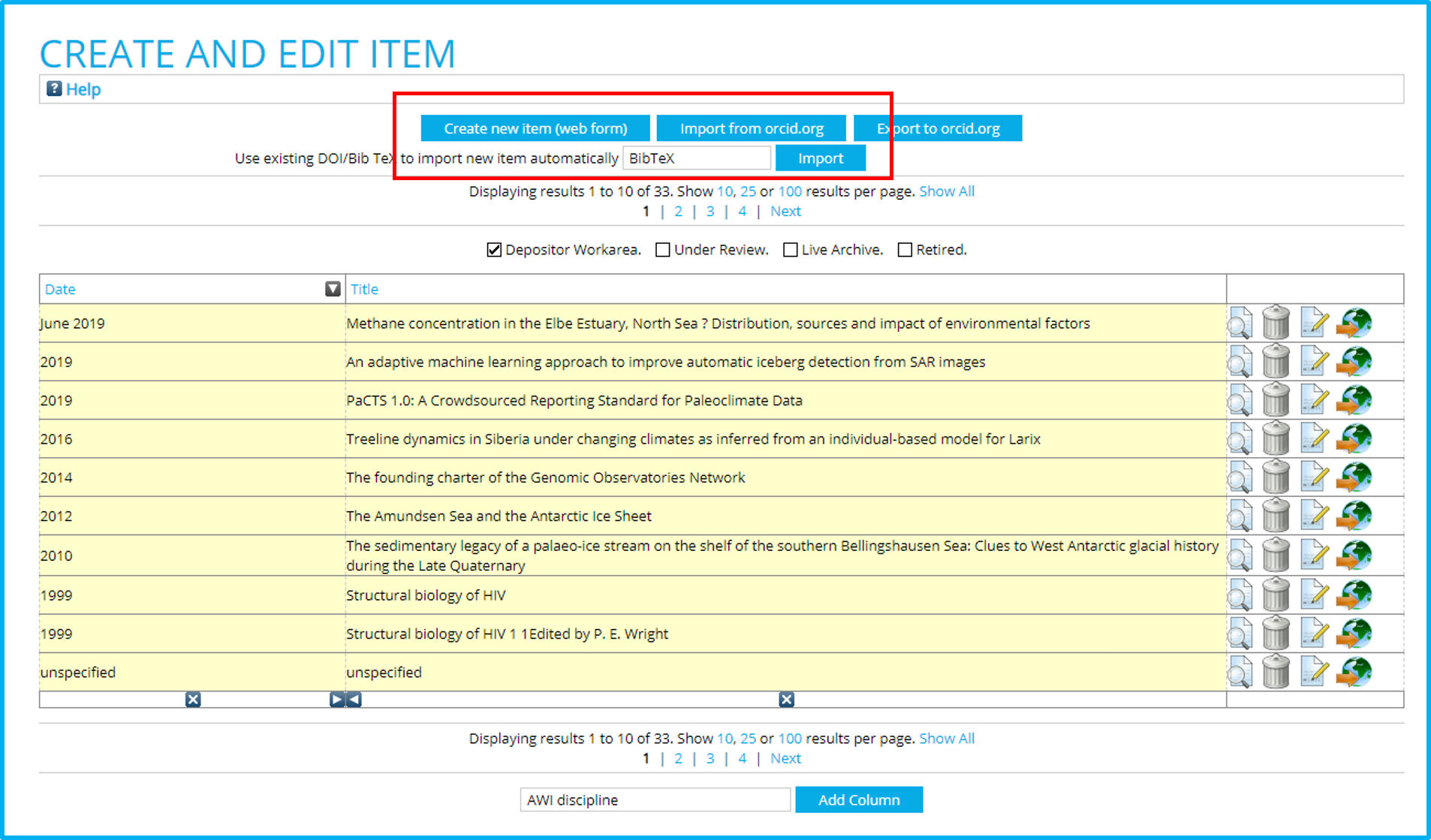 Image Added
Image Added
Create
 Image Removed
Image Removed
items
Items can be created by: (1) manually editing EPIC's submission form or (2) using import solutions. Import solutions enable import direct from DOI (via CrossRef) or direct in BibTex,XXXX formats (see below)Users who want to store in EPIC items which : this option is ideal for items which have not been published yet (e.g. an article in press) or do not have a DOI will have to create the items manually. These must be kept in the (e.g. talks, posters, field reports). In case you have entered an article which has not been published yet, you should keep it in your "User Workarea" until it has been accepted the article has a DOI and thus ready for revision by assigned editors (use the "Save for later" option instead of "Deposit"; see "Understanding the Workflow" below). The recommended workflow for articles is to wait until a resolvable DOI is available which will give users clearly the advantage of importing the bibliographic metadata directly (2) importing from resolvable DOIs : this option is ideal for articles for which an official DOI is available as it automatically imports all the exsiting bibliographic metadata as available direclty from CrossRef. In In this case users users will only have to complete additionally enter the AWI-specific metadata fields metadata (e.g. username/email for AWI authors, research platforms, grant ID, etc). (3) . The "Deposit" option can then be used immediately. The item will then be movied to the editor workspace who will be notified via email immediately. Editors are then responsible for placing the items in "live" archive where they will no longer be editable by regular users. Once in "live" archive, items can only be edited by the respective divison/section editors (see internal list) or librarians (request to pub-bib at awi.de). importing from BibTex: this option is ideal for items which are already in a BibTex formatted reference document. |
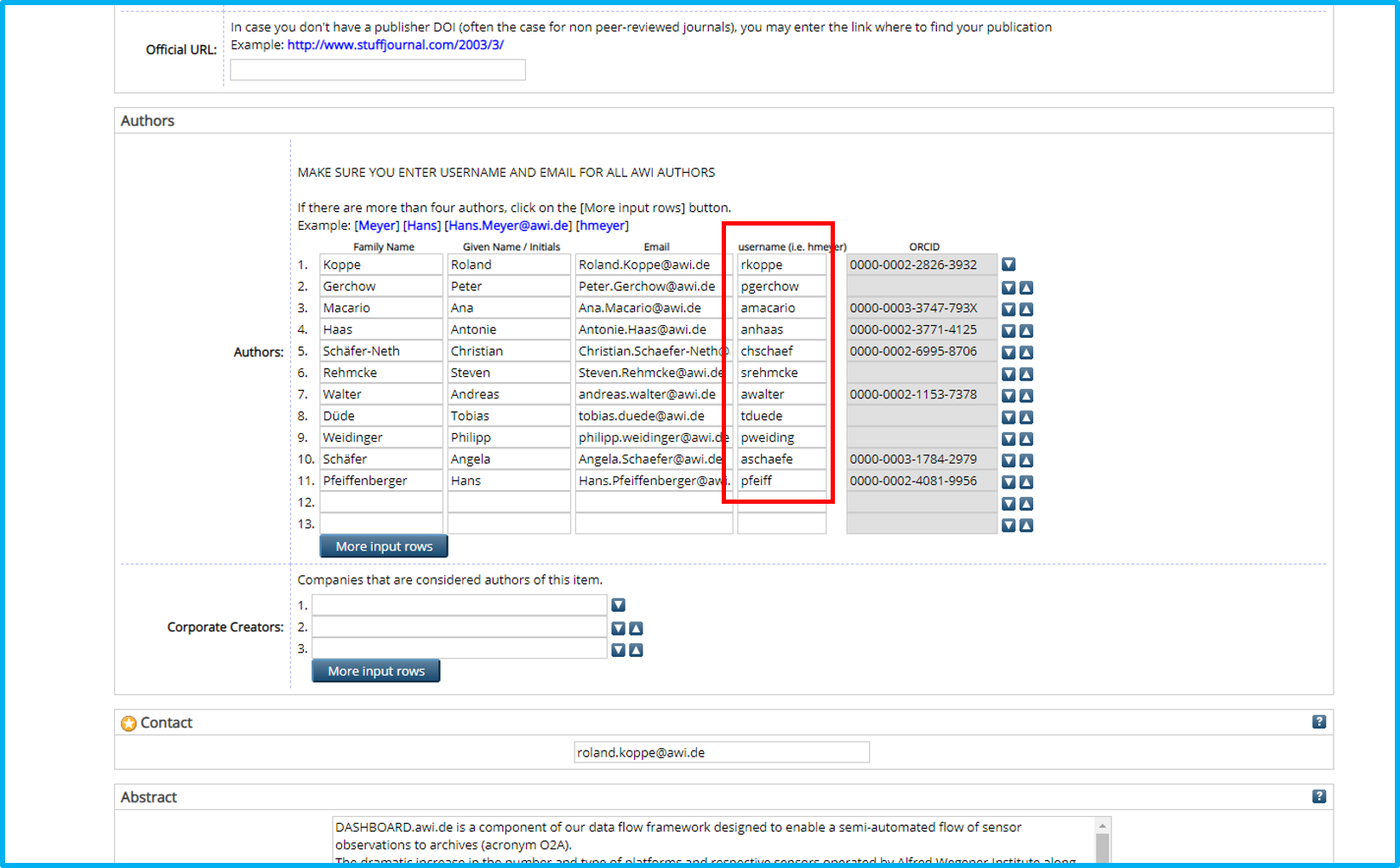 Image Added
Image Added
Submit items for revision
Items created in EPIC are automatically stored in the "User Workarea" when the option "Save for later" is selected. In the context of Helmholtz revision process, it is particular important that the following metadata fields for all articles, theses, books and chapters in books, are correclty entered: (1) official DOI for articles: the DOI allow us to automatically tag your item to a PANGAEA dataset, if applied. The official DOIs are also used to find out the impact of your articles in various social media along with citation information as provided by the alternative metrics "Altmetrics" badge in the landing pages. (2) authors: all AWI authors must be assigned AWI email, username and ORCID (if available). Use the auto-completion functionality to avoid typos. Only items for which the AWI username is available and in "Live archive" will be found in AWI personal homepages. (3) divisions/work packages: the organizational units of all AWI authors must be entered accordingly. Items which do not allign with Helmholtz research must be tagged with "Helmholt Inependent research" option. (4) platforms/campaigns: research platforms operated by AWI (and respective campaigns) used to acquire the data used in publications, presentations, thesis and field reports must be tagged accordingly. This enables the assignment of EPIC items to expeditions/campaigns in the framework of the DATA portal (see "Re-using the metadata" below) |
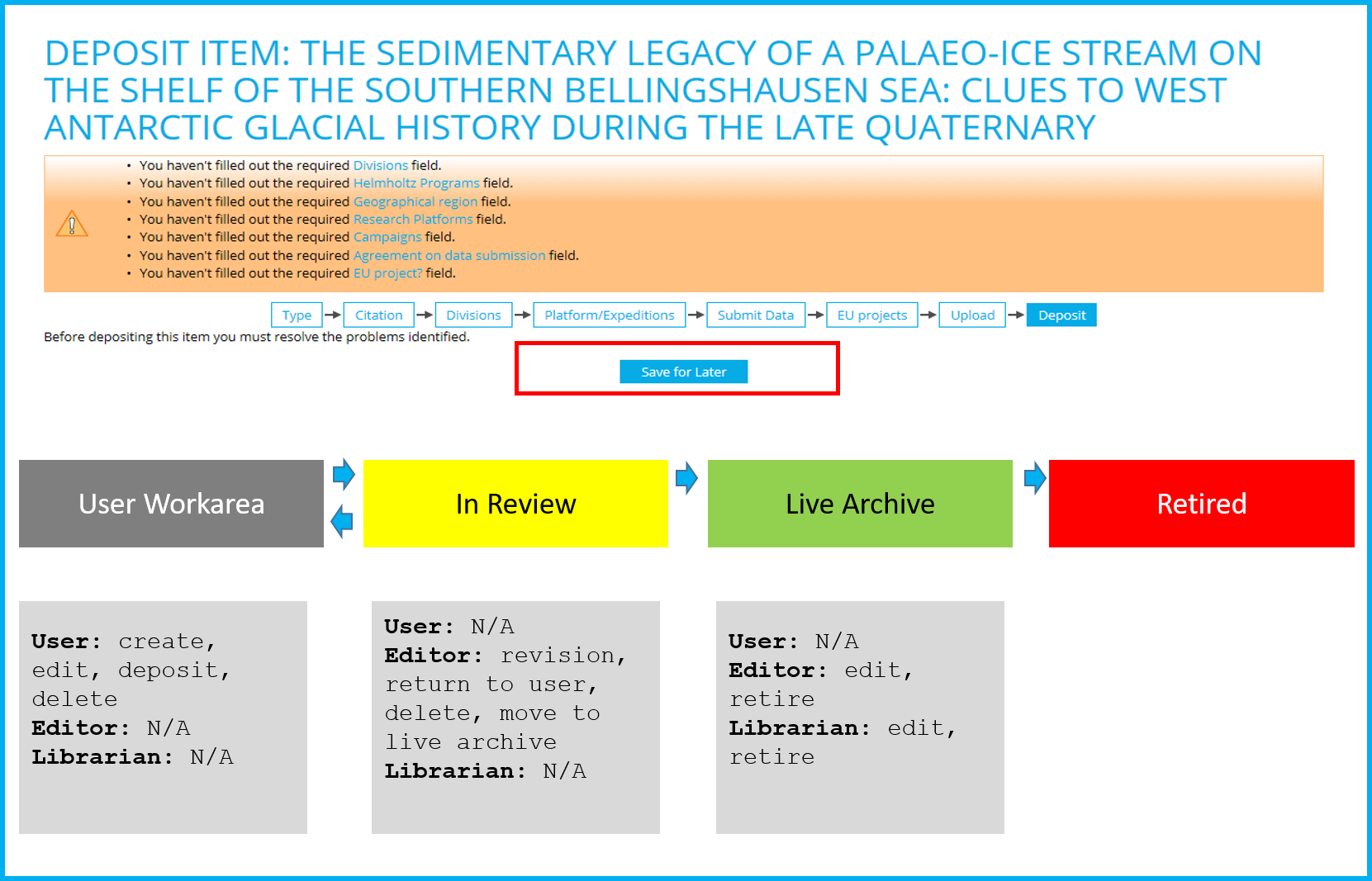 Image Added
Image Added
Understand the workflow
Users are only allowed to edit items in their own "User Workspace". Once the metadata is complete and the PDF has been uploaded, users may click on the "Deposit" option. This will automatically move the item you created from workflow status "User Workarea" to "Under review" and an email notification is then sent to editors. Items will then be reviewed by editors for metadata correctness and placed in "Live archive" as soon as possible. Once in live archive, items are then automatically displayed in AWI personal homepages and an individual persistent unique identifier is created (type handle; example: hdl:10013/epic.8a437225-08fc-4e53-99e3-cd67dbfe1424). Once in "Live archive", items of type article, book, chapter in book and theses, relevant for the Helmholtz metrics, will be bibliographically revised by librarians. Please note that items in "Live archive" |
 Image Removed
Image Removed
Importing items into EPIC
The recommended workflow for articles is to wait until a resolvable DOI is available which will give users clearly the advantage of importing the bibliographic metadata directly from CrossRef. In this case users users will only have to complete the AWI-specific metadata fields (e.g. research platforms, grant ID, etc).
The "Deposit" option can then be used immediately. The item will then be movied to the editor workspace who will be notified via email immediately. Editors are then responsible for placing the items in "live" archive where they will no longer be editable by regular users.
Once in "live" archive, items can only be edited by the respective divison/section editors (see internal list) or librarians (request to pub-bib at awi.de).
 Image Removed
Image Removed
Understanding the generic workflow
The recommended workflow for articles is to wait until a resolvable DOI is available which will give users clearly the advantage of importing the bibliographic metadata directly from CrossRef. In this case users users will only have to complete the AWI-specific metadata fields (e.g. research platforms, grant ID, etc).
The "Deposit" option can then be used immediately. The item will then be movied to the editor workspace who will be notified via email immediately. Editors are then responsible for placing the items in "live" archive where they will no longer be editable by regular users.
Once in "live" archive, itemscan only be edited by the respective divison/section editors (see internal list) or librarians (request to pub-bib at awi.de). |
 Image Removed
Image Removed
Assigning AWI authorship to items and organizational units
In order to be able to distinguish among AWI authors and non AWI authors, it is crucial that all metadata in the "Author" field is correctly filled out. For AWI authors users should additionally enter the AWI email, user ID and ORDID, if available. For the sake of minimizing typing errors, we offer an autocompletion of these fields using the user profiles for AWI staff.
All items must be tagged to a division/section and a Helmholtz research topic/program. The selected organizational units shoudl reflect the affiliation of all AWI authors listed in the items. Items which do not allign with Helmholtz research must be tagged with Helmholt Inependent research. Users who cannot find their division/section listed shoudl contact epic at awi.de
 Image Removed
Image Removed
Assignment to research platforms and field expeditions
You will be requested to assign a short name for all items you want to create. Items are uniquely identified via a local URN identifier (URN means Uniform Resource Locator) using the item type and individual short name syntax .. Example: vessel:ms_hel:fb_740602 points to the ferrybox on MS Helgoland.
While creating a short name for your device, keep in mind that the short names cannot be modified once created because they are in-use within INGEST and STORAGE (for setting the path to data files for a particular item). Be also aware that you cannnot create items with the same short name under one parent item. In case you do need to change a sort name, please contact o2a-support@awi.de
 Image Removed
Image Removed
Integrating your ORCID to EPIC
We recommend you to use the autocompletion functionality (simply type the first 3 characters of the station label as listed in PANGAEA's expedition catalogue) to confortably get the metadata fields under "Action" filled out for you and this way avoiding possible typos. The autocompletion functionality for station metaddata is supported for all large and middle-sized german vessels (Polarstern, Sonne, Metero, Alkor, Heincke, Poseidon).
It is also important to keep in mind that for actions in which a
Only items in "Live Archive" are displayed in AWI personal homepages. Items in "Live archive" have a handle and thus should not be deletetd. However, in exceptional cases in which an item should no longer be shown, it can be hidden from the public by placing it under status "Retired". Email to epic at awi.de or pub-bib at awi. de should be sent in case you need to hide an item. |
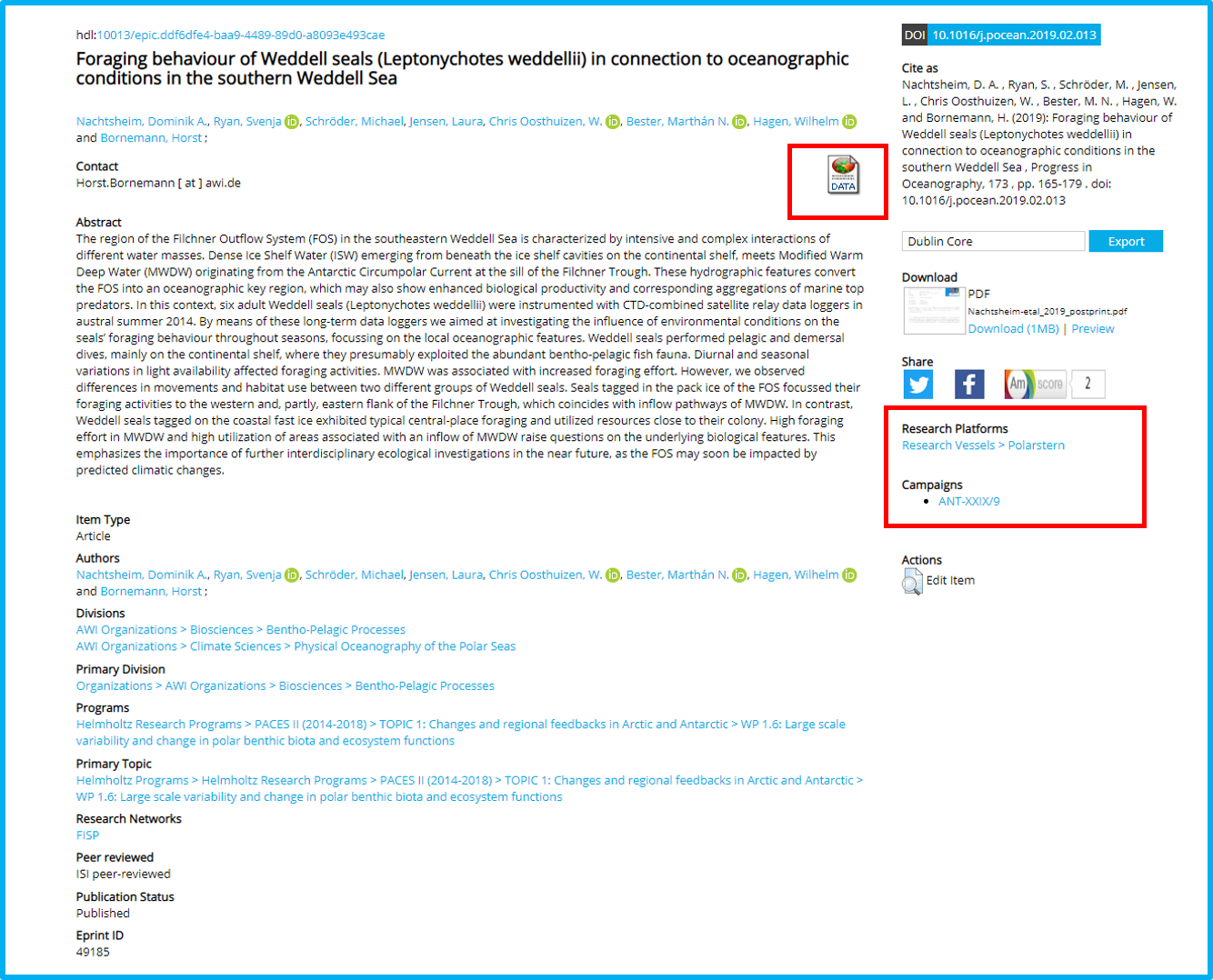 Image Added
Image Added
Archive and cite data
Following the Guidelines for Safeguarding Good Scientific Practices, you are advised to archive all data related to publications in a certified and cite-enabled repository. For AWI data, in particular for the data acquired using AWI research platforms, the recommended information system is PANGAEA which is a CoreTrustSeal certified repository . We strongly advise you to submit your data using https://pangaea.de/submit/ as soon as possible so that you can examplary insert the dataset DOI in the article's reference list in time. Data archival in PANGAEA follows the FAIR Guiding Principles for scientific data management and stewardship. The extensive curational and editorial services often require processing times ranging from several days to several weeks, depending on the data volume and complexity. To prevent data to be publicly available before the related manuscript is published, PANGAEA offers the "in review" dataset status which supports, upon demand, the provision of an access token for the data peer-revision process. PANGAEA additonally provides password protection for datasets under moratorium if wished (for ongoing projects, as example). As depicted in the example , datasets archived in PANGAEA will be automatically shown using a PANGAEA icon in EPIC landing/abstract pages for all |
 Image Removed
Image Removed
Connecting EPIC articles to PANGAEA datasets
Following the guidelines for Good Scientific Practices, you are advised to archive all data related to your publications. All datasets and data products archived in PANGAEA will be automatically listed in the EPIC landing pages of individual articles in which an official DOI has been give provided as "Supplement" for a dataset archived in PANGAEA. |
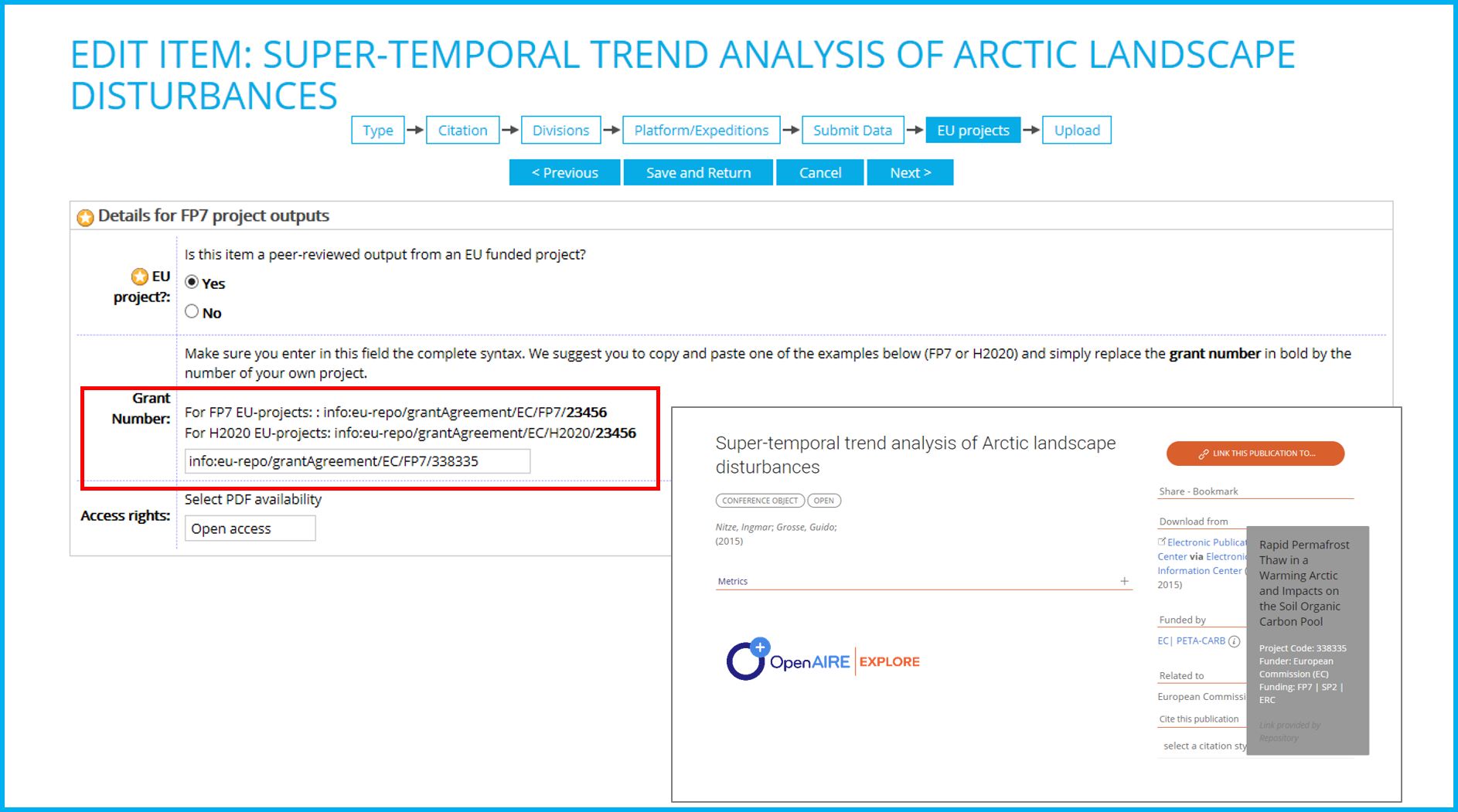 Image Added
Image Added
Link publication to EU grant numbers
EPIC enables tagging to an EU grant number (FB7 and H2020). Make sure you exactly follow the syntax rules as displayed in the help text. By tagging your items to the corresponding EU grant, you are susporting openAIRE to create statistics of various funding agencies and projects. The grant number is automatically displayed in the individual landing page of articles, if provided. Example: |
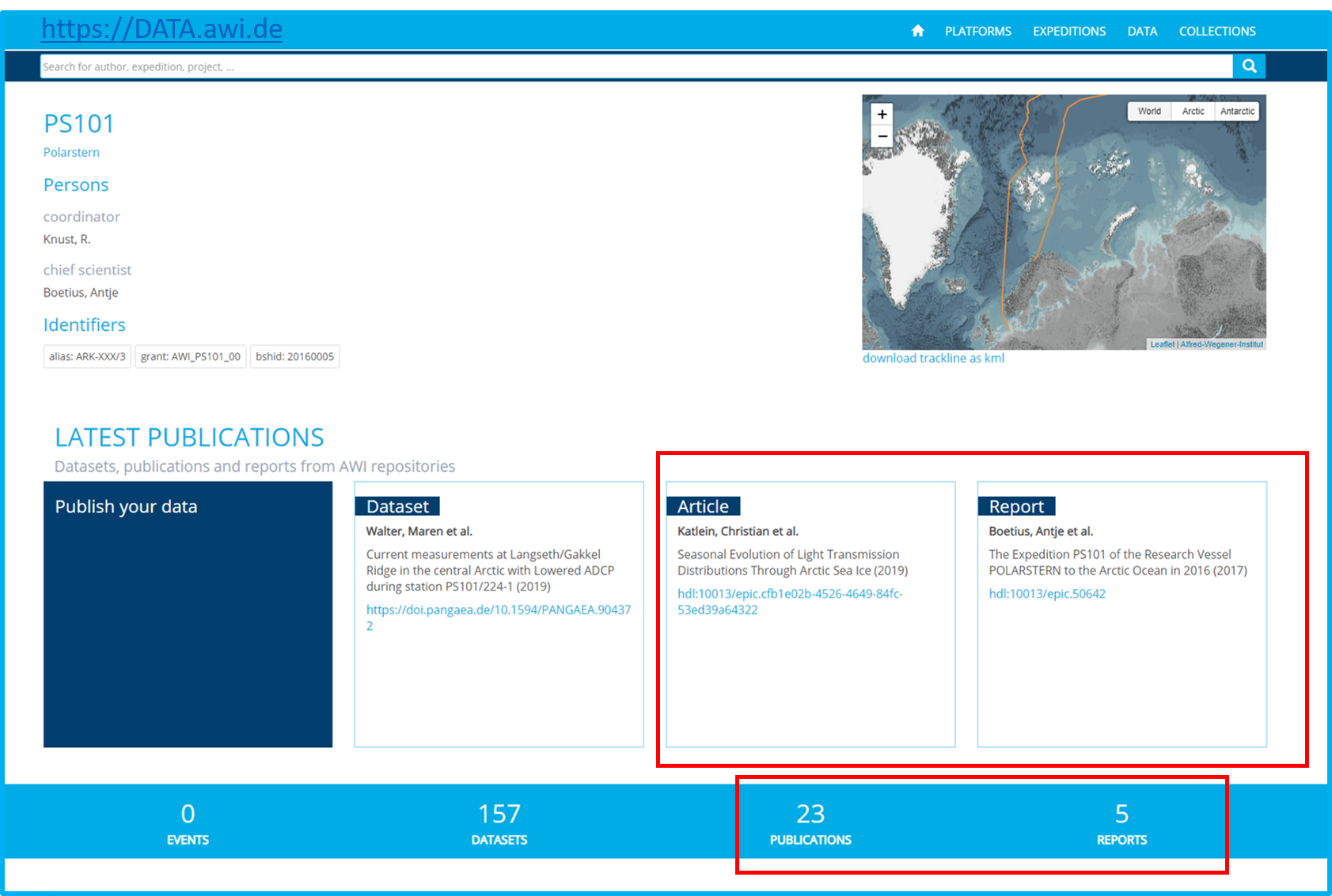 Image Added
Image Added
Type once, re-use often
EPIC supports the export of the metadata associated with an individual item as well as the listing of items resulting in a given search criteria (e.g. all ISI articles from A. Boetius). Items can be exported in various formats individually or by making a bulk export using the advanced search interface. The metadata in EPIC is also being used in the framework of the AWI DATA portal. In this case EPIC's metadata is being harvested on a daily basis and displayed in the context of expedition/campaigns and in the facetted search. Examples are:
EPIC can also be used to archive key resources related to devices and sensors described in https://sensor.awi.de (e.g. data processing reports, calibration documents, factsheets; use type "Miscellaneous"). |
 Image Removed
Image Removed
Cloning items
 Image Removed
Image Removed
Linking your publication to a grant number
EPIC enables tagging to a grant number
 Image Removed
Image Removed
Exporting your publications
| When inserting an action to an item, users may request the creation of an individual persistent identifier for the item which automatically allows user to cite the item accordingly (citation syntax included). The PID (along with the citation) can thus be used in PANGAEA as link to a device/platform used in a particular event. In the PANGAEA example https://doi.pangaea.de/10.1594/PANGAEA.857507 the PID of type handle generated by SENSOR hdl:10013/sensor.664525cf-45b9-4969-bb88-91a1c5e97a5b is used to descrobe the payload of an AUV during a specific event/station on board of RV Merian. |
- Powered by Atlassian Confluence 8.5.7
- Printed by Atlassian Confluence 8.5.7
- Report a bug
- Atlassian News